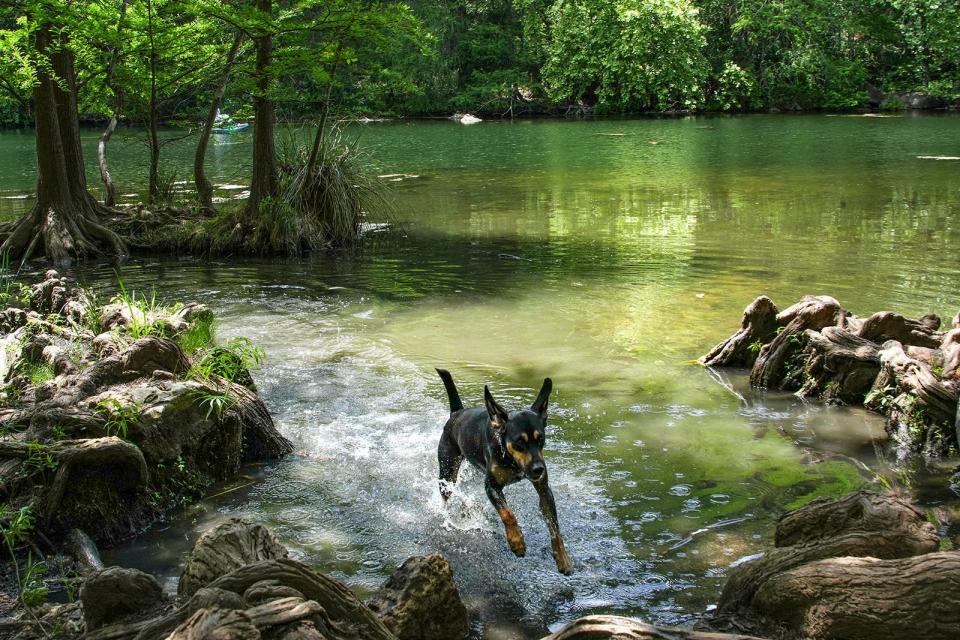It's back: Pet-deadly, harmful blue-green algae detected in Lady Bird Lake, Lake Austin
It feels like Austin has barely begun to warm up and already a familiar foe has been detected in local waterways: the toxin-producing blue-green algae.
Austin officials said the algae, which can be harmful to humans and deadly to pets, was detected at nearly every monitoring site in Lady Bird Lake and Lake Austin, except for at the Walsh Boat Landing.
"We recommend that people and pets avoid contact with algae, not drink water directly from the lake, and rinse off after contact with the water," a city press release stated. "Do not allow dogs to lick their fur prior to rinsing. Please note that swimming is prohibited in Lady Bird Lake."
Cyanobacteria, the blue-green algae's official name, doesn't always produce toxins, and so far it's unknown if the current algae detected is toxic. However, Austin scientists warned that all algae in these bodies of water should be considered toxic while they wait for test results to come back from the lab, which will likely be in June.
Typically, blue-green algae will become toxic in nutrient-rich, warm, stagnant water. When this happens, it's called a harmful algae bloom or proliferation.
More: Austin expands battle with harmful, pet-threatening algae to north shore of Lady Bird Lake

How long has the city been fighting blue-green algae?
City officials said they will continue using a clay-like substance called Phoslock to help fight algae blooms near Red Bud Isle and east of Interstate 35 beginning in late June. The gray, cat litter-like substance is sprayed on the water and traps phosphorus, which is a nutrient the algae need to grow.
The city's Watershed Protection Department first began using it near Red Bud Isle two years ago and saw treatments aid in lowering nutrient and toxicity levels in that area. Last year, Austin scientists began using it east of I-35, but they said the program was not as successful, possibly due to rainfall and increased water flow.
Officials have previously said that Phoslock is safe for humans.
Blue-green algae first popped up in Lady Bird Lake in 2019, with scientists discovering it at Lake Austin the following year. It has been detected every year since, according to officials. Several dogs died in 2019 during a harmful algae bloom.
Scientists conduct biweekly monitoring at six different locations along Lady Bird Lake and Lake Austin during the summer and early fall. If blue-green algae are detected, they take samples of the algae and water and then send those off to the lab to be analyzed. The results are then posted online when they're available.
"Analyzing the algae for toxins takes time," the press release said. "The tests are unusual, complex and not readily available. They are being done at university labs for research purposes."
What to do if you're worried about exposure to blue-green algae
If you or your pet recently had contact with one of these bodies of water and begin to experience symptoms, call your medical provider or veterinarian immediately.
Symptoms in people include stomach pain, headaches, muscle weakness, dizziness, vomiting, diarrhea and liver damage.
More: 'It happened so fast': Owners describe last moments of 3 dogs who died after Lady Bird Lake visits
For dogs, blue-green algae can be deadly within a matter of hours or days after exposure. Symptoms can include excessive salivation, vomiting, fatigue, staggered walking, difficulty breathing, convulsions and liver failure.
You can also call the Texas Poison Control Center at 1-800-222-1222 if you believe you've been exposed. City officials also ask that you fill out a survey to let them know if you believe you've been poisoned by blue-green algae.
Officials said they are not monitoring creeks for blue-green algae, but they said it could be present in those bodies of water. People wanting to play in the water with their four-legged friends should stick to flowing, cool bodies of water to avoid danger.
This article originally appeared on Austin American-Statesman: Blue-green algae detected in Lady Bird Lake and Lake Austin

